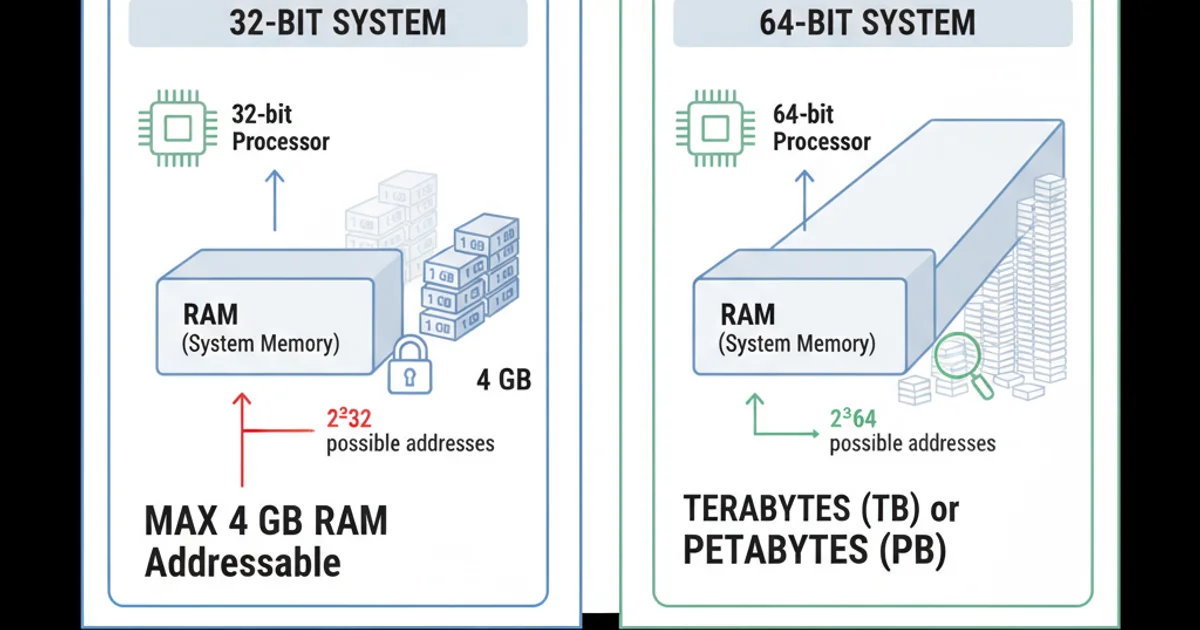What is the difference between a 32-bit and 64-bit processor?
Categories:
Understanding 32-bit vs. 64-bit Processors

Explore the fundamental differences between 32-bit and 64-bit processors, their impact on system performance, memory addressing, and software compatibility.
In the world of computing, you've likely encountered the terms '32-bit' and '64-bit' when discussing operating systems, software, or even the processors themselves. These terms refer to the size of the data units (or 'words') that a processor can handle at one time, which has significant implications for how your computer performs, how much memory it can access, and what software it can run. This article will demystify these concepts, explaining the core differences and why they matter for your computing experience.
The Core Difference: Data Word Size
At its heart, the distinction between a 32-bit and a 64-bit processor lies in the size of the data 'word' it can process. A 'bit' is the smallest unit of data in computing, representing a 0 or a 1. A 32-bit processor can handle data in chunks of 32 bits, while a 64-bit processor can handle chunks of 64 bits. This larger word size allows 64-bit processors to perform more complex calculations and process more data simultaneously, leading to improved performance in many applications.
flowchart TD
A[Processor Type] --> B{Data Word Size}
B --> C[32-bit: 32 bits per operation]
B --> D[64-bit: 64 bits per operation]
C --> E[Limited Memory Addressing]
D --> F[Extensive Memory Addressing]
E --> G[Older Software Compatibility]
F --> H[Modern Software Compatibility & Performance]Conceptual difference between 32-bit and 64-bit processors
Memory Addressing Capabilities
Perhaps the most critical difference between 32-bit and 64-bit architectures is their ability to address system memory (RAM). A 32-bit processor uses 32-bit memory addresses, which means it can theoretically address 2^32 unique memory locations. This translates to approximately 4 gigabytes (GB) of RAM. Even if you install more than 4GB of RAM in a 32-bit system, the processor simply cannot access it all.
In contrast, a 64-bit processor uses 64-bit memory addresses, allowing it to address 2^64 unique memory locations. This is an astronomically larger number, equating to approximately 18 exabytes (EB) of RAM. While current technology doesn't allow for that much physical RAM, this capability ensures that 64-bit systems can utilize far more than 4GB of RAM, which is crucial for demanding applications like video editing, large databases, and modern gaming.
Software Compatibility and Performance
The bit architecture also dictates software compatibility. A 64-bit operating system can run both 32-bit and 64-bit applications (though 32-bit applications will run in a compatibility mode, often called WoW64 on Windows). However, a 32-bit operating system can only run 32-bit applications. You cannot install or run 64-bit software on a 32-bit OS.
For performance, 64-bit applications running on a 64-bit operating system and processor can leverage the larger registers and increased memory access, leading to significant performance improvements, especially in tasks that require heavy computation or large datasets. Modern software, including most operating systems, web browsers, and productivity suites, is optimized for 64-bit architecture.

Memory addressing capabilities: 32-bit vs. 64-bit
In summary, while 32-bit processors served their purpose for many years, 64-bit architecture has become the standard due to its superior memory addressing capabilities and enhanced performance for modern software. When purchasing new hardware or installing an operating system, opting for 64-bit is almost always the correct choice for future-proofing and optimal performance.